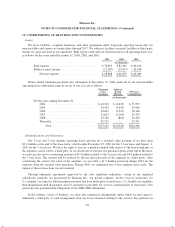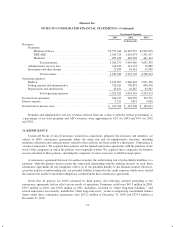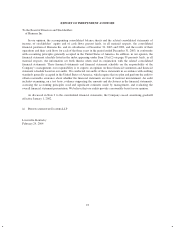Humana 2003 Annual Report Download - page 103
Download and view the complete annual report
Please find page 103 of the 2003 Humana annual report below. You can navigate through the pages in the report by either clicking on the pages listed below, or by using the keyword search tool below to find specific information within the annual report.
ITEM 9. CHANGES IN AND DISAGREEMENTS WITH ACCOUNTANTS ON ACCOUNTING AND
FINANCIAL DISCLOSURE
Not applicable.
ITEM 9a. CONTROLS AND PROCEDURES
We carried out an evaluation, under the supervision and with the participation of our Chief Executive
Officer, or CEO and Chief Financial Officer, or CFO, of the effectiveness of the design and operation of our
disclosure controls and procedures including our internal controls over financial reporting for the quarter ended
December 31, 2003.
The Company’s management, including the CEO and CFO, does not expect that our disclosure controls and
procedures including our internal controls over financial reporting will prevent all error and all fraud. However,
they have been designed to give reasonable assurance about the effectiveness of the design and operation of our
disclosure controls and procedures including our internal controls over financial reporting. A control system, no
matter how well conceived and operated, can provide only reasonable, not absolute, assurance that the objectives
of the control system are met. Further, the design of a control system must reflect the fact that there are resource
constraints, and the benefits of controls must be considered relative to their costs. Control system limitations
include the realities that judgments in decision-making can be faulty, and that breakdowns can occur because of
simple error or mistake. Additionally, controls can be circumvented by the individual acts of some persons, by
collusion of two or more people, or by management override of the control. The design of any system of controls
also is based in part upon certain assumptions about the likelihood of future events. Over time, controls may
become inadequate because of changes in conditions, or the degree of compliance with the policies or procedures
may deteriorate. Because of the inherent limitations in a cost-effective control system, misstatements due to error
or fraud may occur and not be detected.
Based on this evaluation, our CEO and CFO concluded that our disclosure controls and procedures
including our internal controls over financial reporting are effective in timely alerting them to material
information required to be included in our periodic SEC reports. There have been no significant changes in our
internal controls over financial reporting or in other factors that are reasonably likely to affect those controls over
financial reporting during the Company’s quarter ended December 31, 2003.
In this regard, our CEO and CFO have signed the certifications required by Sections 302 and 906 of the
Sarbanes-Oxley Act. These certifications are filed as Exhibits to this Annual Report on Form 10-K.
Additionally, our CEO will sign the certificate as to compliance with the Corporate Governance Listing
Standards adopted by the New York Stock Exchange.
95
























